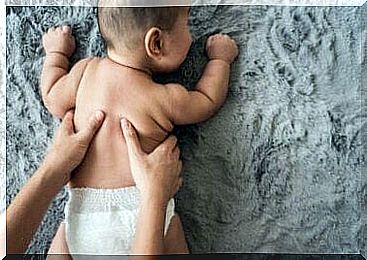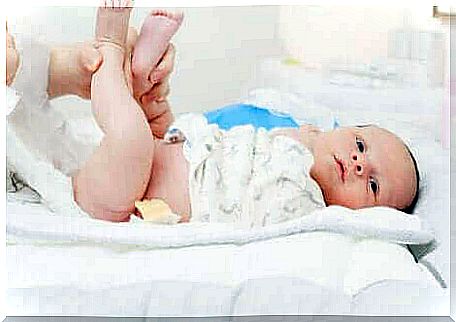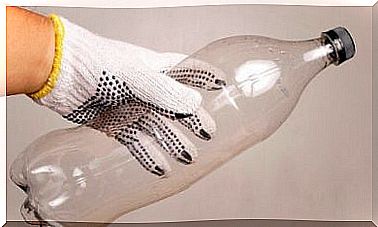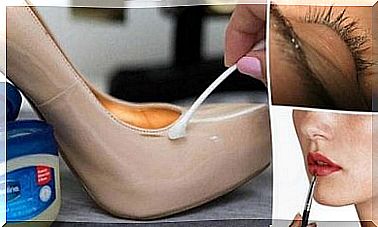The Sacrococcygeal Dimple: What Is It And How Does It Affect The Baby?
Sacrococcygeal dimples can be a simple indentation in the skin or be related to developmental pathologies in some cases. We explain everything you need to know and its implications.

Some babies have a small cutout in the lower back. This area is also called the lumbar region or the sacral region because the sacrum is the bone found there. This is why this small indentation is called the sacrococcygeal fossa.
This dimple can be a simple hollow that does not cause any discomfort or symptoms. However, sometimes this depression is related to the spinal canal, which can lead to problems with the nervous system. This is why we explain in this article everything you need to know about it and how it is treated.
What is a sacrococcygeal dimple?
As we mentioned, a sacrococcygeal dimple is a notch or indentation that appears in the lower back. It is present from birth. As specialists from the Mayo Clinic explain, it is usually located just above the crease in the buttocks.
Most dimples of this type are harmless. However, a certain percentage of them are associated with spinal dysraphism. According to an article in Acta Pediatrica, spinal dysraphism refers to certain birth defects that cause incomplete closure of certain structures, such as the spine.
This is a heterogeneous group of malformations that lead to greater exposure of neural tissue. In the same study, researchers say that between 40 and 95% of babies with spinal dysraphism have skin changes. In many of these cases, this alteration can be a sacrococcygeal dimple.
It is especially important to suspect that the dimple is dangerous if it is close to a tuft of hair or if there are changes in skin color nearby. The problem is that in these cases, due to the neural alteration, there may be neurological, urinary, rectal or even orthopedic alterations. That is why it is essential to distinguish them and treat them.
Types of sacrococcygeal dimples
A sacrococcygeal dimple can be typical or atypical. It is this simple distinction that allows us to tell the difference between a benign situation and something serious. A typical or simple sacrococcygeal dimple is a small dimple, located in the crease between the buttocks.
They are usually no more than five millimeters in diameter. In addition, they are close to the edge of the anus. They are quite frequent and do not involve any risk of dysraphism. In fact, it is estimated that they appear in almost 5% of healthy newborns.
On the other hand, there are atypical dimples. They are larger in size. They are more than half a centimeter deep and are farther from the anus. Finally, they can be located near the sides.
An atypical dimple is considered a risk factor for spinal dysraphism. When they are very deep, there may be abnormal communication with the spinal canal. The spinal canal is a very sensitive structure through which many nerve fibers pass.
Therefore, this communication can cause spinal and neurological damage. This type of dimpling can be accompanied by changes in skin color, bumps, or even areas of unusual hair growth.
What is the difference from pilonidal cyst?
As the Clínica Universidad de Navarra explains, a pilonidal cyst is a cyst that contains hairy formations inside. Like the sacrococcygeal dimple, it is found in the intergluteal area, just above the buttocks.
What happens in the pilonidal cyst is that hair, cells, waste, and fluids build up, resulting in a plugging. It usually develops after birth. It is more common in men and often becomes infected. Finally, it causes significant pain and swelling.
Causes of the sacrococcygeal dimple
So far, the causes of sacrococcygeal dimple formation have not been identified. We know that they are not congenital, that is to say present from birth. This, as we pointed out in the previous section, helps to distinguish it from the pilonidal cyst.
Atypical dimples can be derived from this lack of closure of midline structures. However, it is not clear exactly why this is happening.
What are the symptoms and how is a sacrococcygeal dimple diagnosed?

Usually, a sacrococcygeal dimple does not cause any symptoms. This is because, for the most part, they are mere dimples. It is only a skin change in the lower back.
However, an atypical sacrococcygeal dimple may be associated with some symptoms. It depends on whether this is really an indicator of spinal dysraphism. Therefore, to detect it, a thorough physical examination is necessary.
It is essential to measure and verify the characteristics of the dimple. If it is very large or deep, a series of additional tests should be performed to study it. The same is true if other dimples appear, if there is discoloration of the skin, or if the skin is far from the anus.
According to a study published in the Archives of Disease in Childhood , ultrasound is one method of studying dimpling. When abnormalities are found, it is estimated that the probability of a spinal problem is multiplied by six.
Ultrasound is a preferable technique because it is inexpensive, quick and safe. However, if there is any doubt about the diagnosis, an MRI may be performed. It allows a more precise study of the tissues.
Possible complications
Complications from a dimple appear with atypical dimples. They can be linked to spina bifida or attached spinal cord syndrome, among other conditions.
Spina bifida is a birth defect. What is happening is that the neural tube is not closing properly. There are different types, but the one related to the sacred dimple is spina bifida occulta.
It is characterized by a small breach in the spine. This gap appears because the spine is not developing at this time. It may not produce symptoms and is usually detected in adolescence or adulthood.
On the other hand, attached spinal cord syndrome occurs when scar tissue anchors the spinal cord. It can lead to urinary and fecal incontinence, weakness in the lower limbs, or even difficulty standing.
Treatment of sacrococcygeal dimples
For a dimple, no specific treatment is needed or available. The only thing that is essential is to prevent dirt from building up in the area. Otherwise, infections can occur because it is very close to the anus and can be contaminated with bacteria in the gut.
This is why, when they are still babies, it is essential to clean the area well and to pay attention to the diapers. If the dimple is atypical, treatment may be necessary depending on the risk.

Each case should be examined and studied by a doctor. In children with a neural tube closure defect, surgical techniques may be necessary to overcome the defect.
How to proceed according to the state of the problem?
Ideally, all newborns should be examined thoroughly. If a sacrococcygeal dimple is observed, a first study of the dimple should be performed. We measure the dimple there and look for other signs or alterations around it.
If everything else is normal, the child is healthy, and the sacred dimple is small, there is nothing more that can be done. On the other hand, if there are warning signs or if the dimple is atypical, the child should be referred to a specialist.
It will be essential to explore the dimple more closely. In addition, it will be examined whether the baby may have neurological damage or developmental defects. Likewise, depending on the results, the best treatment for each case will be considered.
The bottom line is that most sacrococcygeal dimples are simple. They are only a small alteration of the skin. However, it is essential to rule out that it is a neurological problem. That is why it is always advisable to consult a doctor.









